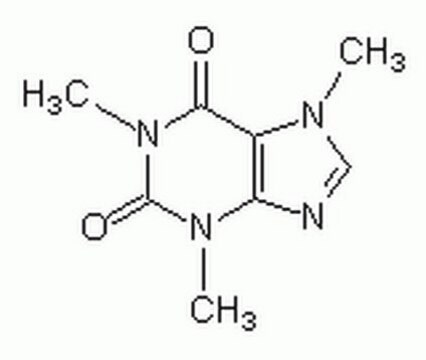W222402
Caféine
anhydrous, 99%, FCC, FG
Synonyme(s) :
1,3,7-triméthylxanthine
About This Item
Halal
Kosher
anhydrous
Produits recommandés
Source biologique
synthetic
Niveau de qualité
Qualité
FG
Halal
Kosher
anhydrous
Conformité réglementaire
EU Regulation 1334/2008 & 178/2002
FCC
FDA 21 CFR 182.1180
Essai
99%
Forme
powder
Pf
234-236.5 °C (lit.)
Solubilité
H2O: soluble 18.7 g/L at 16 °C
Application(s)
flavors and fragrances
Documentation
see Safety & Documentation for available documents
Allergène alimentaire
no known allergens
Propriétés organoleptiques
odorless
Chaîne SMILES
CN1C(=O)N(C)c2ncn(C)c2C1=O
InChI
1S/C8H10N4O2/c1-10-4-9-6-5(10)7(13)12(3)8(14)11(6)2/h4H,1-3H3
Clé InChI
RYYVLZVUVIJVGH-UHFFFAOYSA-N
Informations sur le gène
human ... ADORA1(134) , ADORA2B(136) , ADORA3(140) , PDE4B(5142)
mouse ... Adora2b(11541)
rat ... Adora1(29290) , Adora2a(25369)
Vous recherchez des produits similaires ? Visite Guide de comparaison des produits
Catégories apparentées
Description générale
Application
- Anti-hair loss effect of a shampoo containing caffeine and adenosine.: Discusses the efficacy of a shampoo formulated with caffeine and adenosine in reducing hair loss, underscoring caffeine′s role in enhancing hair follicle activity and promoting hair health (Chen et al., 2024).
Produit(s) apparenté(s)
Mention d'avertissement
Warning
Mentions de danger
Conseils de prudence
Classification des risques
Acute Tox. 4 Oral
Code de la classe de stockage
11 - Combustible Solids
Classe de danger pour l'eau (WGK)
WGK 1
Équipement de protection individuelle
dust mask type N95 (US), Eyeshields, Faceshields, Gloves
Faites votre choix parmi les versions les plus récentes :
Déjà en possession de ce produit ?
Retrouvez la documentation relative aux produits que vous avez récemment achetés dans la Bibliothèque de documents.
Les clients ont également consulté
Notre équipe de scientifiques dispose d'une expérience dans tous les secteurs de la recherche, notamment en sciences de la vie, science des matériaux, synthèse chimique, chromatographie, analyse et dans de nombreux autres domaines..
Contacter notre Service technique




